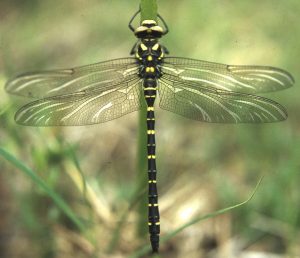 It is many years since the naturalists in the Highlands diverted their attention from the very popular birds or wildflowers. Slowly the remarkable insects of the Highlands started to become popular and to start with it was the moths. Very many more species than the butterflies and some comparatively difficult to identify. One advantage of them was the ability to catch them and study them in the garden using a lamp and other harmless means to attract them. Then this was followed by another fascinating group with an intriguing life history, the dragonflies. Some of the dragonflies are also very attractive such as the photograph of the golden ringed dragonfly that has a 100mm wing span. Partly through the enthusiasm of a few local naturalists and the increasing role of the British Dragonfly Society, the interest in dragonflies started to gather momentum. In a way it culminated in the Societies outstanding “Atlas of Dragonflies in Britain and Ireland”. The atlas served to highlight the potential of the Highlands and the fact that not only were there many rarities but also some outstanding sites to be found that no one had recorded before.
It is many years since the naturalists in the Highlands diverted their attention from the very popular birds or wildflowers. Slowly the remarkable insects of the Highlands started to become popular and to start with it was the moths. Very many more species than the butterflies and some comparatively difficult to identify. One advantage of them was the ability to catch them and study them in the garden using a lamp and other harmless means to attract them. Then this was followed by another fascinating group with an intriguing life history, the dragonflies. Some of the dragonflies are also very attractive such as the photograph of the golden ringed dragonfly that has a 100mm wing span. Partly through the enthusiasm of a few local naturalists and the increasing role of the British Dragonfly Society, the interest in dragonflies started to gather momentum. In a way it culminated in the Societies outstanding “Atlas of Dragonflies in Britain and Ireland”. The atlas served to highlight the potential of the Highlands and the fact that not only were there many rarities but also some outstanding sites to be found that no one had recorded before.
Of course a few outstanding sites had long been known through the efforts of the very few local dragonfly enthusiasts and three of them are meccas for enthusiasts. Two are close to Inverness with one being a comparatively small site at Loch Bran near Foyers on the west side of Loch Ness. This has the ideal combination of shallow and deep margins with a great deal of floating, emerging and submerging plants and is well sheltered by woodland, ideal conditions for a range of dragonflies with over 10 breeding species. It is also very close to a minor road which helps access. A much larger area with several sites is Glen Affric to the south east of Inverness. One good site here, again very small, is the Corrie Loch which is on one of the Forestry Commission’s walkways and routes to enable access. I once saw a hobby over the Corrie Loch catch and eat a large dragonfly in flight. It would have been a hobby from Scandinavia rather than from one of the few breeding in the south of the UK. Then there is the area at the west end of Loch Maree near the Beinn Eighe National Nature Reserve at Kinlochewe.
As for Glen Affric the latest good news is from the October issue of the British Dragonfly Societies (BDS) Newsletter which came to me via e-mail last week. It outlines the 2016 stage of the management for dragonflies in Glen Affric and an open invitation to all would be volunteers who would like to take part. Glen Affric supports a number of BDS Priority Sites and they include three dragonflies that are Endangered, Vulnerable and Near Threatened species on the world Red List. These are, in order, the white faced darter, azure hawker and the northern emerald. The sites have suffered from unsympathetic management in the past but the BDS, in partnership with the Forestry Commission Scotland, Trees for Life, the National Trust for Scotland and North Affric Estates are working together to change all this. A series of practical tasks will begin at the end of October. The aim is to work with volunteers on sites which were previously used as forestry plantations, blocking the drainage ditches to retain the water and remove small trees that would dry out the wetland, thus starting the natural peatland process. If you are interested in helping with this vital and interesting work for the future of the Highland dragonflies then contact the British Dragonfly Society ( Telephone 01933 3897 748 )
Tags: highland wildlife
